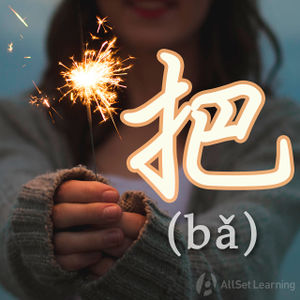Advanced uses of "ba"
-
Level
-
Similar to
-
Used for
-
Keywords
- Also known as: 把字句 ("bǎ"zìjù), 把 construction, preposition 把, disposal construction and pre-transitive 把.
Once you've gotten the hang of the basic 把 (bǎ) sentence pattern, you can start to use it in some more complex and abstract ways.
Contents
Using 把 with 给
This 给 is used in oral Chinese to add emphasis to the verb. The 给 is actually fully optional, but it's good to be familiar with this pattern because it's so commonly used in spoken Chinese.
You'll notice a structural similarity to this 给 used with 把, and the 给 used with 被.
Structure
Subj. + 把 + Obj. + 给 + Verb Phrase
Examples
- 我 把 这 事儿 给 忘 了 。I forgot about this thing.
- 周末 我 把 脏 衣服 给 洗 了 。On weekends, I wash the dirty clothes.
- 你 能 把 这 些 都 给 记住 吗?Will you be able to remember all of this?
- 他 把 我的 手机 给 摔坏 了 。He dropped my phone and broke it.
- 妈妈 把 没 用的 东西 都 给 扔了 。Mom threw away all of the useless things.
Using 当作 or 看作
When you want to say that something is treated as something else, use this pattern.
Structure
把+ Obj.+ 当作 / 看作 + something else
Examples
- 我 一直 把 他 看作 我 哥哥。I always see him as my older brother.
- 他 把 我家 当作 了 他 自己 家 。He treated my house like his own.
- 很 多 留学生 都 把 自己 的 中文 老师 当作 朋友。Many study abroad students treat their Chinese teachers as their friends.
- 孩子 可以 把 家里 的 很多 小 东西 当作 玩具。Kids treat small things in the house as toys.
- 很 多 子女 把 父母 的 理想 当作了 自己 的 理想。Many kids make their parents' ideals their own ideals.
Take something seriously with 当回事
当回事 is mostly used in colloquial Chinese. It means to take something seriously or to hold something in high regard. It is usually used with the negative 不.
Structure
(别/不)把 + Obj.1 + 当回事
- 他 从来 不 把 老板 的 话 当回事。He never took what his boss said seriously.
- 你 这个 人 总是 太 把 自己 当回事 了。You take yourself too seriously.
- 有的 父母 从 不 把 孩子 的 一些 小 问题 当回事! Some parents never take their kids' problems seriously.
- 我们 班 有 几 个 学生 从来 不把 老师 的 作业 当回事。 Our class has a few students who never take the teacher's homework seriously.
Using 把 with a verb + 成
In this case, 成 can be translated as "into."
Structure
把+ Obj. 1 + Verb + 成 +Obj. 2
Concrete Verb Examples
In the first example, we are using concrete verbs such as 切, 做, 分, etc. Obj. 2 would also be concrete.
- 请 你 把 这个 蛋糕 切成六块。Please cut the cake into six parts.
- 我 知道 怎么 把 图片 做成视频。I know how to make this picture into a video.
- 老师 把 全班 同学 分成了 三个 小组。The teacher broke the whole class' students up into three small groups.
Abstract Verb Examples
In the example below, we are dealing with more abstract verbs. These verbs include 换, 变, 改, 看, 当, 转, etc.
- 我 每个 月 都 要 把 这些 美元 换成人民币。Every month, I have to convert some USD into RMB.
- 他 把 自己 的 家 换成了 他的 工作室。She converted her house into her workspace.
- 你 能 把 这个 文件 的 格式转成PDF吗?Can you convert this file into a PDF.
- 韩国 政府 把 “汉城” 改成了 “首尔”。The South Korean government changed the capital name from Hanseong to Seoul.
- 请 你 把这些 句子翻译成中文。Please translate these sentences into Chinese.
Mistaken Perception Examples
The example below is when somebody mistakes something for something else. This can be either mishearing, misspelling, seeing something as something else, etc. These verbs include 看, 听, 写, 记, etc.
把+ Obj. 1 + Perception Verbs
- 他 把 “太“ 看成了“大”。He saw 太 as 大.
- 你 刚才 把 “政府” 读成了 “丈夫” 。Just now you read 政府 as 丈夫.
- 我 常常 把 “自己” 的 “己” 写成“已经” 的 “已”。Just now you read 政府 as 丈夫.
- 你 是不是 把 “派对” 听成了 “排队”?Just now you read 派对 as 排队.
- 对不起,我 把 早上的面试 记成了下午。Sorry, I wrote the morning interview down for this afternoon.
See also
Sources and further reading
Books
- A Practical Chinese Grammar For Foreigners (外国人实用汉语语法) (pp. 469-70) →buy
- Basic Patterns of Chinese Grammar (pp. 53-4) →buy
- Chinese Grammar Without Tears (简明汉语语法学习手册) (pp. 167-81) →buy
- Common Chinese Patterns 330 (汉语常用格式330例) (pp. 3-5) →buy
- Integrated Chinese: Level 1, Part 2 (3rd ed) (pp. 142-4) →buy
- Integrated Chinese: Level 2, Part 2 (pp. 225-7, 321-3) →buy
- Mandarin Chinese: A Functional Reference Grammar (pp. 482) →buy
- Modern Mandarin Chinese Grammar: A Practical Guide (pp. 354-5) →buy
- New Practical Chinese Reader 2 (新实用汉语课本2) (pp. 41-2, 88) →buy
- New Practical Chinese Reader 3 (新实用汉语课本3) (pp. 15, 51, 101-2) →buy
- 40 Lessons for Basic Chinese Course (基础汉语40课下册) (pp. 369-70, 384, 398-9)→buy
Websites
- Mandarin Essential Grammar (Yale): 把 Construction
- CTCFL (Oxford): The 把 Construction
- ChinesePod: Qing Wen - The Magic Word 把 (free podcast content)
- ChinesePod: Qing Wen - 把 Humbug (free podcast content)
- FluentU: The Definite Guide to the Chinese Ba Construction
- Mandarin Online: 把字句
- Just Learn Chinese (blog): Lesson 10 How to understand and use Chinese sentence pattern “…把…”?



